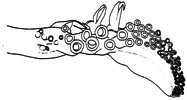Abralia trigonura
Kotaro TsuchiyaIntroduction
A.trigonura belongs the A. andamanica species group. It is characterized by having two or three hooks on the manus, the left arm hectocotylized and complex eye photophores. This species resembles A. andamanica and A. siedleckyi but is separable by its robust tail and dark body color from the former, and the lesser number of photophores on the ventral funnel from the latter species.Characteristics
- Tentacle clubs
- Two or three hooks on ventral side.
- Two rows of large suckers on dorsal side of manus.
 image info
image info
- Hectocotylus
- Left ventral arm of male hectocotylized.
- Hectocotylus with two different sized off-set flaps.
 image info
image info
- Eye Photophores
- Five, complex organs: two large terminal opaque organs and three intermediate silvery organs.
 image info
image info
- Integumental Photophores
- Ventral mantle and head with scattered arrangement of integumental organs.
- Mantle apex ("tail")
- Broad and extends well beyond conus of gladius.
Comments
A. trigonura is similar to A. andamanica, A. siedleckyi, A. heminuchalis, and A. veranyi in its complex ocular photophores and left ventral arm hectocotylization.Life history
Age and reproduction
Female longetivity is up to 6 months, and sexually maturity is reached at 3.5 months. Male longetivity is same as female, and sexually maturity is reached at 2.5 months. The smallest mature female is 31mm DML, and 80% of females are mature at 35mm DML. Males sexually matured between 23-27mm DML. This species seems to be a multiple spawner, and spawn eggs every few days. Female batch fecundity was roughly 290-430 eggs (Young and Mangold, 1994)Eggs
Spawned eggs are slightly ovoidal, 0.9 mm x 0.79 mm, usually with a slightly greenish tint, clear, and with a sticky colorless jelly coating (Young and Harman, 1985).Distribution
Vertical Distribution
In the Hawaiian waters, this species was considered to be an important component of mesopelagic boundary community (Reid et al., 1991), and vertically migrates from upper mesopelagic depths during the day to the upper 50 m at night (Young, 1978), and generally stays during the daytime >5m above the ocean floor (Young, 1995). Young stages occur primarily outside the mesopelagic boundary zone. Adult is inhabited in outer mesopelagic boundary zone during daytime, and migrates inner mesopelagic boundary zone during night (Young, 1995).Geographical Distribution
This species is broadly distributed in tropical West to Central North Pacific (Hidaka and Kubodera, 2000).References
Young, R.E. 1995. Aspects of the natural history of pelagic cephalopods of the Hawaiian mesopelagic-boundary region. Pacific Science, 49:143-155.
Young, R.E. and Harman, R.F. 1985. Early life history stages of enoploteuthin squids (Cephalopoda: Teuthoidea: Enoploteuthidae) from Hawaiian waters. Vie Milieu, 35:181-201.
Young, R.E. and Mangold, K.M. 1994. Growth and reproduction in the mesopelagic boundary squid Abralia trigonura. Marine Biology, 119: 413-421.
Title Illustrations
Left:Abralia trigonura, off Hawaii, side view of adult. Photograph by R. E. Young. Right: Abralia trigonura, Northwest Pacific, from Tsuchiya, 2000, size, sex.
Other illustrations
- Tentacular club, from Tsuchiya (2000), size, sex.
- Hectocotylus, from Tsuchiya (2000), size, sex.
- Eye photophores, from Tsuchiya (2000), size, sex.
About This Page
Tokyo University of Fisheries, Konan, Minato, Tokyo
Page copyright © 2000
Citing this page:
Tsuchiya, Kotaro. 2000. Abralia trigonura . Version 01 January 2000 (under construction). http://tolweb.org/Abralia_trigonura/19657/2000.01.01 in The Tree of Life Web Project, http://tolweb.org/








